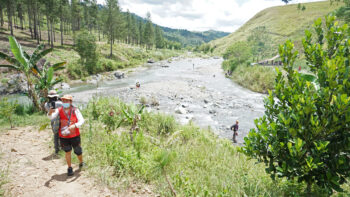
Art Exhibit Review
Ongoing at TheBauhaus Gallery
Dona Vicenta Village (across Victoria Plaza)
March 15-27, 2021
DAVAO CITY (MindaNews / 17 March) – As the world celebrates the Women’s International Month, TheBauhaus Gallery in Davao City opens its gallery space to images of women of different colors, shades, textures, type of beauties and different artistic representations. The exhibit involves 34 works of art; mainly paintings and one sculpture. These are the works of 26 artists – five women and the rest men – who are mainly Davao-based.
Paintings are mostly acrylic on canvas, and a few oil on canvas. Two paintings (by Jay Bueno) are rendered in fiberglass-reinforced resin with these titles: Nasalanta and Settler Jacking. Bueno – along with Kublai Millan, Anoy Catague, Bong Espinosa – are the known artists whose works are included in this exhibit.
Millan once more opens a new vista of his ever-expanding visual images; still very much anchored in Lumad aesthetics but exploring new forms. Catague’s two pieces entitled Dabkimu and Pahiyom manifest both his versatility in the use of Lumad images to convey women’s beauty and a unique style of combining colors and textures. Espinosa’s (Bunga and Biyaya) celebrate the fertility of women and her being rooted in Mother Nature. Jeff Bangot’s Galing-Galing also takes a pride of place alongside these known visual artists.
One can tell that these visual artists have reached a certain level of recognition and can now attract the attention of collectors by the price tag attached to the works of art. For it is the goal of TheBauhaus not just to exhibit works of art but help the artists find a place in the art market. On the other hand, one can tell that this exhibit has welcomed promising young artists whose price tags are very affordable to those who do not have deep pockets but had an eye for young talents and the promise of their art works.
The lone sculpture is that of Jong Tangiday with his Mebuyan and Child. Sculpted from salvaged driftwood, Tangiday once more shows his mastery in appropriating what others might consider debris into fabulous works of art celebrating the legendary narrative of Mebuyan, the goddess with a hundred breasts who nourish babies in her sanctuary below Mt. Apo.
So what is this exhibit all about? The curators of this exhibit has come up with this introductory note to this exhibit:
A BAYI evolves in every age of the world. There is a great cycle of going away and returning, then leaving and going back again among every Bayi to restore that deep knowledge and wisdom.
These cyclic state are present in each woman, but are not necessarily chronological, since some mid-age women experience rebirth, old women become fierce lovers, and little girls know how to cast spells even without saying a word. When we celebrate women, should we speak from the voice of a feminist? Should we start the celebration with the mother since it is a popular Bayi definition? This could be very offensive for a woman who is impassioned about her freedom to make choices for her own body.
How should we celebrate women?
In this artistic celebration – which was inaugurated on Tuesday, March 16, 2021 and will run for two weeks (up to March 27) – women’s images traverse across a myriad range of images that include many of the Jungian archetypes of women. In this collection are images of the mother, the lover, the goddess, the victim, the wise woman and the amazon.
These visual representations represent various arms forms from the representational to the cubist, the abstract to social realism and the whimsical to the magical. As can be expected of Mindanawon artists, there is a good number of the paintings about Lumad women from the various ethnolinguistic communities of southern Philippines.
Most interesting is that there are less paintings with English titles (Joaquin Sala’s The Birth of Angels, Reagan Deipare’s Asset, Grenlie Jumamoy’s Let Her Be, George Abangar’s The Windows of the Beautiful Soul and Lonisa Andamon’s Crabs and Roses). The range of Cebuano-Bisaya titles to the art works dominate the labels attached to the paintings (from Joaquian Selo’s Tampisaw to Ibrahim Pakab’s Tukma sa Alimpatakan and Victor Dumaguing’s Habak-habak ni Eba 1 and 2).
The more discerning art critic may provide a critical assessment of this collection as uneven as it brings together works of masters and raw talents, the recognized artists and the promising ones. One can certainly notice that much can be desired in terms of making this exhibit truly one with a high aesthetic level.
However, this is where TheBauhaus asserts its right to not make such rigid categorizations, to dichotomize the range of artistic possibilities among our artists. After all, who takes on the sole right to judge what is superior art as versus the inferior, the fine versus the rough, the elitist versus the folk? In the end, each viewer certainly has a right to see what is out there being produced by artists and each beholder then make up her/his mind as to what matters to his/her eyes!
And let’s face it – from a feminist perspective the name of the game is INCLUSIVISM.
[MindaViews is the opinion section of MindaNews. Redemptorist Brother Karl Gaspar is a professor at St. Alphonsus Theological and Mission Institute (SATMI) in Davao City and until recently, a professor of Anthropology at the Ateneo de Davao University. Gaspar is author of several books, including “Manobo Dreams in Arakan: A People’s Struggle to Keep Their Homeland,” which won the National Book Award for social science category in 2012, “Desperately Seeking God’s Saving Action: Yolanda Survivors’ Hope Beyond Heartbreaking Lamentations,” two books on Davao history, and “Ordinary Lives, Lived Extraordinarily – Mindanawon Profiles” launched in February 2019. He writes two columns for MindaNews, one in English (A Sojourner’s Views) and the other in Binisaya (Panaw-Lantaw). Gaspar is a Datu Bago 2018 awardee, the highest honor the Davao City government bestows on its constituents.]







